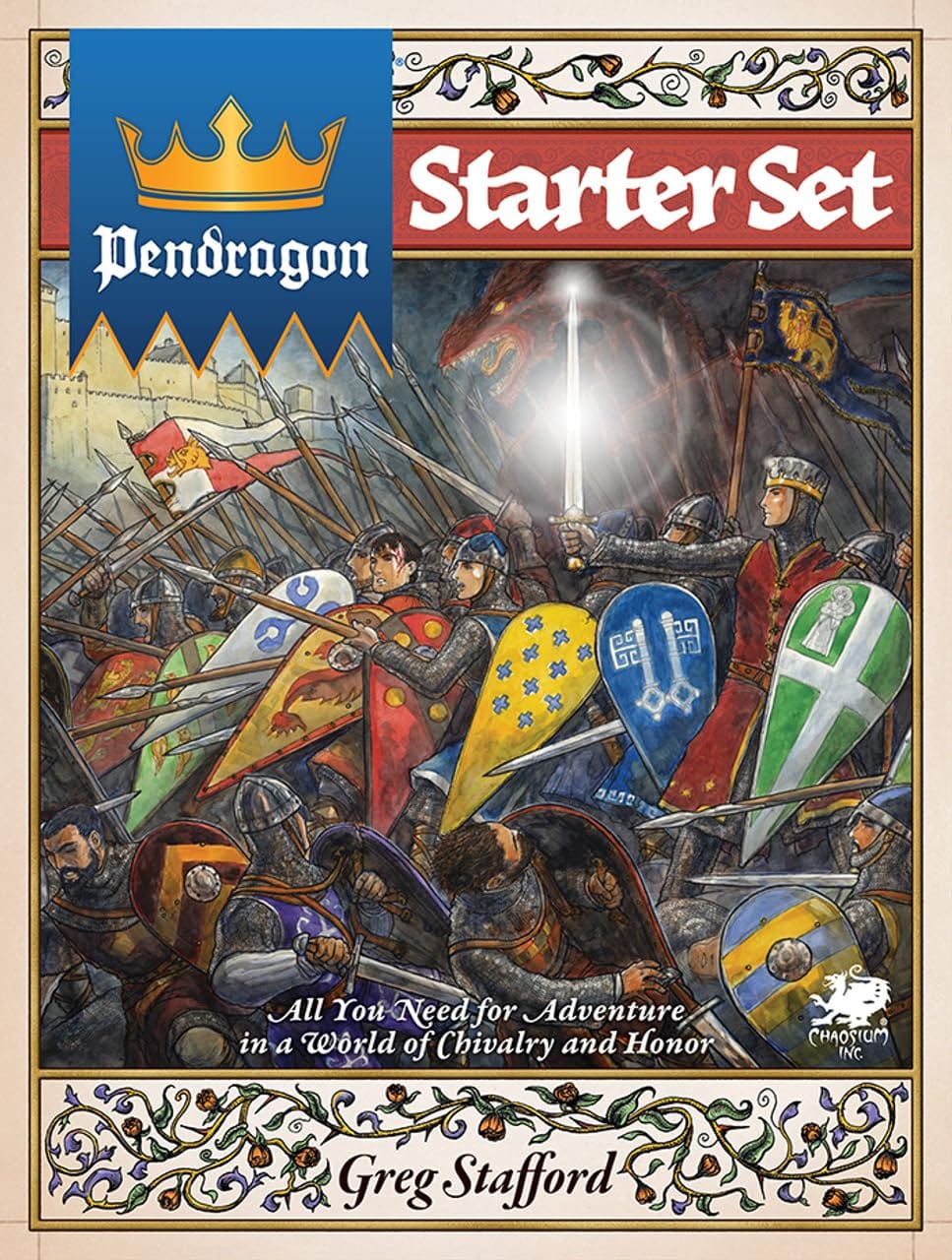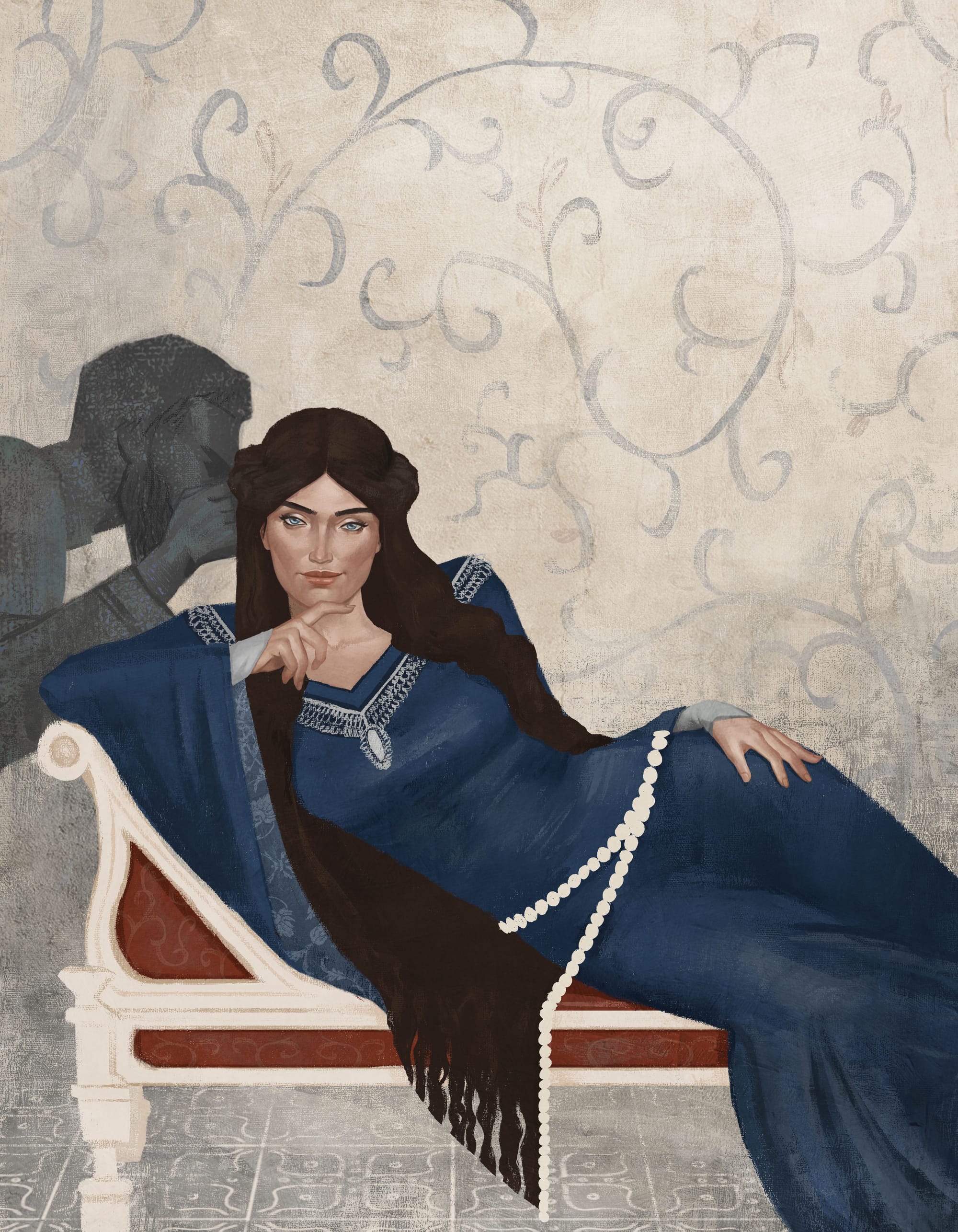
First released in 1985 the late Greg Stafford’s Pendragon is one of the jewels in the RPG crown. An epic game of knightly quests and courtly passions, all set to a backdrop of Arthurian Britain, Pendragon sees players contend with not just the day-to-day business of besting mythic beasts but also negotiating the often contradictory obligations of a feudal, chivalric society and, with its campaigns measured in decades, trying to build a glorious legacy that will last the ages.
Heralding the arrival of the game’s sixth edition is a new starter set, and I think it’s fair to say that Chaosium have some form with these things now. The starter set for Call of Cthulhu’s 7th edition set the benchmark on its release and whilst I ultimately bounced off RuneQuest‘s recent box there was no doubting its intrinsic quality.
So what of Pendragon’s then, a game that for all the many plaudits heaped upon it down the years I have to admit I’ve always admired from a safe distance. If Stafford’s other major achievement, RuneQuest, had seemed a little academic for my teenage tastes, Pendragon felt even more like the full tweed jacket with leather elbow patches, and by the time my own sartorial tastes had caught up with it I’d long packed away my dice.
But it’s not just my wardrobe that’s changed in recent years, the RPG scene is remarkably different from even when Pendragon’s last edition was released in 2005, so can this new edition reintroduce itself to a new generation whilst retaining much of what its devoted fans love about it? On the basis of this starter set I suspect the answer is yes.

Crack open the fairly weighty box and you find three books. There’s the now traditional Choose Your Own Adventure style book to gently ease you into things, a second containing a more thorough run through of the rules and setting, and finally The Sword Campaign. The latter comprising three linked adventures that put the players in a front row seat to witness, and indeed assist in, the birth of Arthur’s legend.
Alongside that there’s several appendices with extra rules for tournaments, overland travel and the like, a hefty stack of pre-generated characters, Battle Cards featuring specific enemies and encounters from the campaign and a handful of dice. Those aware of the historical baggage Pendragon has when it comes to female player characters will be pleased to know the pre-gens include a good mix of male and female characters, and the text repeatedly makes it clear that gender is no barrier to being a knight. All in all it’s a solid bundle to be getting on with and, it must be said, all rather nicely laid out. Extra points awarded for the lovely medieval marginalia dotted around the books.
One of the stumbling blocks I encountered with RuneQuest was what for many is that game’s main draw, the world of Glorantha. Remarkable achievement of world building that it is, coming late to the party felt like joining a class just before the exams with a lot of homework needed to catch up. Pendragon’s world on the other hand, despite its specificity, feels both more malleable and accessible.
Whilst the setting is ostensibly a grounded and historical post-Roman Britain, that’s really a thin veneer under which lays a more mythic land. Just as the likes of Geoffrey of Monmouth, Chretien de Troyes and Sir Thomas Mallory drew upon disparate sources, filtering them through their own eras to assemble their Arthurian cycles, Stafford’s Matter of Britain takes inspiration everywhere from those medieval, and older, texts to the likes of T.H. White’s Once & Future King series, John Boorman’s 1981 fantasy movie Excalibur and elements of the 20th century Neo-pagan revival. As pseudo-historical settings go this is one flexible enough to encompass all manner of strange goings on and anachronisms.
If the setting then is easy enough to wrap your head around, what about the system? On the whole things are simple enough here too, what we’re essentially dealing with is a straightforward d20, roll under a specific skill/characteristic/trait, system. Skills and characteristics will be familiar enough, the former consisting of things like Hunting, First Aid or Sword, whilst and the latter’s Strength, Constitution etc should be even more recognisable.
Having laboured through RuneQuest’s combat system I was delighted to discover that fighting here is fast if pretty brutal, which is fair enough. After all swords, whether gifted by strange women lying in ponds or not, are dangerous things and should feel like it and over the course of several plays my poor squire Camarig repeatedly found himself dumped, unmourned and unremembered, in various ditches outside Londinium.
Traits and Passions though are where Pendragon’s real magic starts to reveal itself. Traits are 13 pairs of oppositional values, such as Chaste and Lustful, whilst Passions are the four intense beliefs your knight holds, like Homage to your Lord or Love for Family. Together these help both define what kind of knight you are and act as a guide, and in some circumstances a constraint, upon how you behave. There are no classes here, everyone plays a knight, so this is really where you start to differentiate your character.
Those used to the kind of absolute player agency that is much loved these days might, at first, find it jarring to be goaded or even forced into acting in a certain way, especially when that way is how some medieval romance writer thought a dark age Christian knight might act. But then again surely that’s the whole point of playing a knight in Pendragon and not just some off the shelf Paladin in whatever flavour of D&D you happen to enjoy.
As much as they are about battling dragons, giants and ghostly headsmen, the Arthurian stories are about people with outsized passions, trying, and often failing, to live up to ideals they’ve set themselves. Pendragon’s Traits and Passions are a great way of both inhabiting those characters and creating a narrative, especially as Traits are self-reinforcing. Lean into the role of a lustful, bawdy Knight and you may find yourself in a world of trouble when a visiting royal’s spouse starts showing you a bit of ankle. Trouble, of course, equals opportunities for conflict, drama and all the good stuff that we sit around a table rolling dice for.
The adventures included are fun if a little railroady, though that’s forgivable when they’re obviously trying to introduce the game to new players, and they set you up nicely to expand your adventures when the new core rulebook arrives in the coming months. I have to say, much like my poor Camarig stumbling into a Faerie circle, Pendragon’s Starter Set has left me charmed and, tweed patches or not, eager to get to grips with a longer campaign and the quest for glory.
Writing: Greg Stafford, David Larkins
Art: Fetisov, Marlot, Smylie, Dirim
Published by Chaosium
This feature originally appeared in Wyrd Science Vol.1, Issue 5 (Dec '23)

